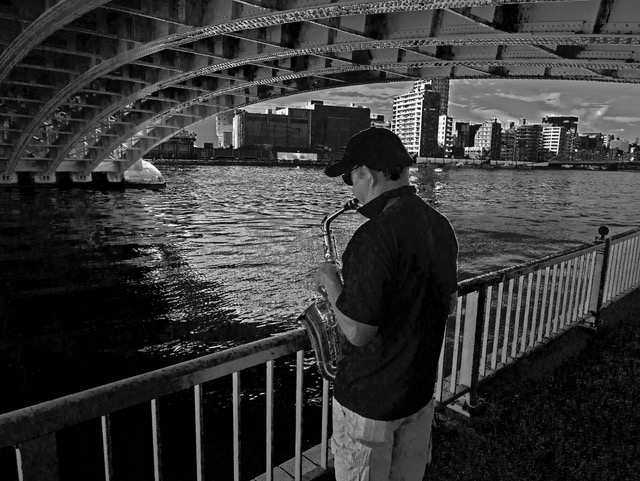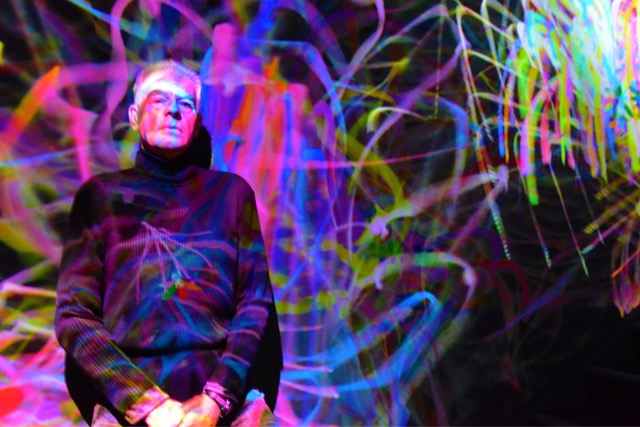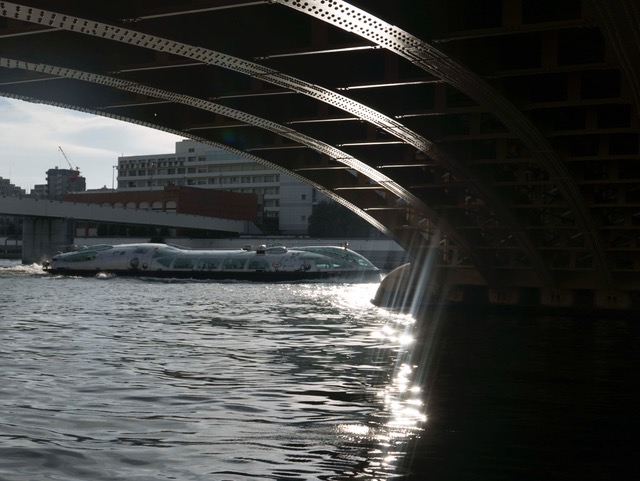by Stephen Mansfield
This essay originally appeared in German as one of six contributions to, then Japan-based German photographer, Hans Sautter’s large format book, ‘Japan.’ Each contributor was assigned a theme to write about, in my case, the Japanese city. This month sees the English language version of the book from an American publisher.
In Maurice Rheims’s book, La Vie estrange des objects, a character, offering a collector a handful of sand mixed with crushed marble and porphyry, suggests, “Take this to your museum and say: This is ancient Rome.” The Japanese equivalent of this episode might be a handful of gray, post-war cement dust, its best effort at antiquity.
Like all cities, the human societies inhabiting Japanese metropolises are far greater than the sum of their historical pasts, or the physical components and materials that constitute their archeological strata. In the pullulating, demographically engorged hives of cities like Tokyo, Osaka and Nagoya, host to endless cycles of birth and death, the forces of renewal and replenishment are primary.
As they engage in ongoing experiments in architecture, town planning and lifestyle, Japanese cities create a circulation of ideas, empirical metaphors and paradoxes based on the effects of passing time. The sense of regret, even bereavement, attached to the loss of heritage buildings in Europe, is less acute in the Japanese urban milieu, which is driven by disintegration, interruption, ruptures, and creative metamorphosis represented as progress. Every new city structure, in this view of metro evolution, is an opportunity to redefine the urban scape, to improve on older archetypical forms. The visitor savors the strangeness of these cities in fleeting, incomplete moments, akin to allowing the mind to freely navigate images contrived by an over-ingestion of psychotropic drugs. And like a powerful chemical infiltration, your own perception will determine whether you experience the city as a wonderland or nightmare.
The rectilinear boulevards of 19th century Paris, designed in part to supersede a cobweb of medieval alleys easily barricaded by the Communards, and the formal grid of urban planner, Ildefons Cerda i Sunyer’s Barcelona, are models of important urban centers that have adapted well to the imperatives of the modern age. It would be a simplification to say that Japanese cities, once defined by a relatively formal order, have succumbed to entirely formless disorder, but this is invariably the first impression. Unlike the calculated irrationality of surrealist art, in which the omission of logical co-ordination between objects and the collapse of spatial assumptions, ignites the imagination with limitless possibilities, Tokyo’s jumble of structures and signage is apt to merely baffle. Compounding the dissonances is a stylistic fondness for the kitsch. Donald Richie went so far as to assert that Japan was a, “kingdom of kitsch and Tokyo is its kapital. Mt Fuji ends up as a tissue dispenser, and the Buddha’s sandals – three meters high – adorn a ferro-concrete temple pretending to be timber.” In the end, the infidelities of style are so prodigious you cease to even notice them.
Today’s supercharged urban centers, fueled by unbridled consumerism, illuminated by garish, fitfully kinetic neon, and masses of signage, have created a landscape akin to urban bricolage. In the contemporary Japanese city, a traditional preference for the discreet, the modestly obtuse, is replaced by a craving for maximum visibility. In acquiring the added function of advertising props, Japanese urban centers have been transformed into surfaces of running commercial text and scroll. In cities like these, where pedestrians for the most part only ever see one side of a building, the one overlooking the street, views are flattened into two-dimensional planes. This sequential, episodic experience of the city is narrative set on constant replay, or re-write, the text as fresh, or shallow, as urgently produced as the script for a TV advertisement. With one set of commercials trying to scramble contiguous signals, style can subsume substance. The result is architecture that, buried under a morass of text messages and images, runs the risk of becoming secondary. In the contemporary Japanese city, it is not heritage buildings but electronic screens that embody the flow of time.
It wasn’t always like this. In photographer Felice Beato’s 1865 Panorama of Yedo from Atagoyama, a monochrome image consisting of five combined albumen prints, we see a singularly ordered, carefully zoned city. Japan’s Edo era (1603-1868) was micro-managed and class stratified to a degree that edicts and proscriptions were issued on everything from the materials used in building a house, the quality and type of food permissible for consumption, how language, to the usage of grammatical modifiers, verbs and pronouns could be employed, the deployment and striking of facial and gestural expressions, the colors and type of fabrics that could be worn, and even the type of material that could be utilized in footwear straps. The planning of Japanese cities and castle towns was based on a preconceived matrix of auspicious geomancy, social hierarchies and delineated trade districts, a formal space defined and managed by an intrusive, unassailable, authoritarian order. With the dissolution of the totalitarian state, the feudal city prototype, a political as much as social blueprint, was hastily disassembled in favor of an anti-systemic model characterized by subversive freedoms.
The downside of perpetual change are cities with no memory, or at best, accuracy prone collective retention. Few of the structures in Japan’s most prominent cities are historically original. Like literature and film, often requiring a voluntary suspension of disbelief, to fully appreciate architectural reconstructions in Japan, the viewer must enter into a suspension of attachment to the authentic. From the Japanese perspective, replicating the past is a means to understanding the process of tradition. The reconstructed castles of Nagoya and Osaka, with their ferro-concrete buttresses and elevators, are admired for their progressive additions, rather than ostracized as adjuncts to architectural duplication.
If European cities, with strict preservation laws and zoning regulations, are models of controlled order and surveillance in the higher cause of heritage, Japanese cities epitomize creative anarchy driven by economic imperatives, novelty, and a thirst for renewal. This presupposes the risk of mediocrity, and yet these cities represent some of the most electrifying urban spaces on earth. Ultimately Tokyo, with its economic ascendance and cultural dynamism, is the most visible touchstone for change. As its memory landscapes are lost, however, the creed of impermanence becomes a catalyst for psychic instability in an amnesiac city.
Contemplating the wonders and caprices of the fictive metropolis of Eutropia, Italo Calvino wrote, “Mercury, god of the fickle, to whom the city is sacred, worked this ambiguous miracle.” Tokyo also has its presiding deities. Ebisu, the god of commerce, is a prominent figure, but so too is Benten, female patron of music and the arts, a sensual, counterbalancing presence, radiating higher aspirations, tempering venality. If Tokyo has renounced a material past that consolidates memory, the spirit and supernatural worlds endure. One need look no further than the capital’s countless temples, shrines, mortuary halls, Buddhist home altars, ancient tombs and sarcophagi, to the primacy of ceremony, ritual and community festivals, or to the shadows of corporate towers, where faith healers, numerologists, palmists, and fortune-tellers ply their trade, to sense the spirit in the machinery of modern life, to feel time bending backwards. These concrete cities, we must conclude, pulsate with supra-natural forces, their shape-shifting forms supporting a spiritual cosmology that forms a power grid of semi-invisible, but palpably sensed forces. Extending the metaphor of a city devoted as much to the spiritual as the commercial, we find in the relentless superimposing of buildings, each new structure usurping the previous, a cityscape embodying the Buddhist notion of mujo, impermanence.
The common contention that Tokyo is less a city than a series of villages may seem implausible in the contemporary context, but when you move from the corporate central districts of the city, the icy beauty of their buildings, the air perceptibly changes. A warming takes place. The human temperature rises. It would be a mistake, therefore, to characterize Tokyo as a machine, a centrally controlled mechanism, as one prominent writer did. Cities are not machines, though well-lubricated ones like Tokyo possess mechanisms to forestall lassitude, indolence, decline. Far from being an industrial fabrication, the city, in its radical unorthodoxy, is a model of creative evolution, perpetual mutation. Arguably, Tokyo is the prototype of these cities of temporality, metro-scapes that prioritize attachment to ideas over form, that attempt to forestall the decomposition of time with persistent facial surgery. Tokyo’s greatness rests not in an august past, of which there is scant evidence and little interest, but in an endearing optimism about the future, a conviction that the best is yet to come, that the present is a preliminary for something truly extraordinary.
The powerful electromagnetism of the city generates an exuberance, an effervescence of largely unfettered ideas and experimentation that, ultimately, accelerates the dissolution of antiquity, confirming Tokyo’s preference for deliquescence and regeneration. In its ingenuous anarchy, a creative formlessness that is fluid rather than rigid in its refusal to bend to an overarching plan, lies its essential humanity and originality.
Home to the highest nocturnal concentration of light on the planet, one senses the air filling with electrons, thunderheads of impending change massing behind this most existential of cities. How you respond, will depend on whether the city liberates or incarcerates you.
******************************
In After Act, Stephen considers virus related literature in a pandemic world.
For a review of his life in writing, given as a lunchtime talk for WiK, see here.
For a review by John Dougill of his book, Stone Gardens, click here.
For a short treatise on light and dark in Japanese culture, see here. For a review by Josh Yates of Stephen’s book on Tokyo: A Biography, see here.
For Stephen Mansfield’s review of the WiK Anthology 3, Encounters with Kyoto, please click here. For his amazon page with a list of his books, please see this link.









Recent Comments